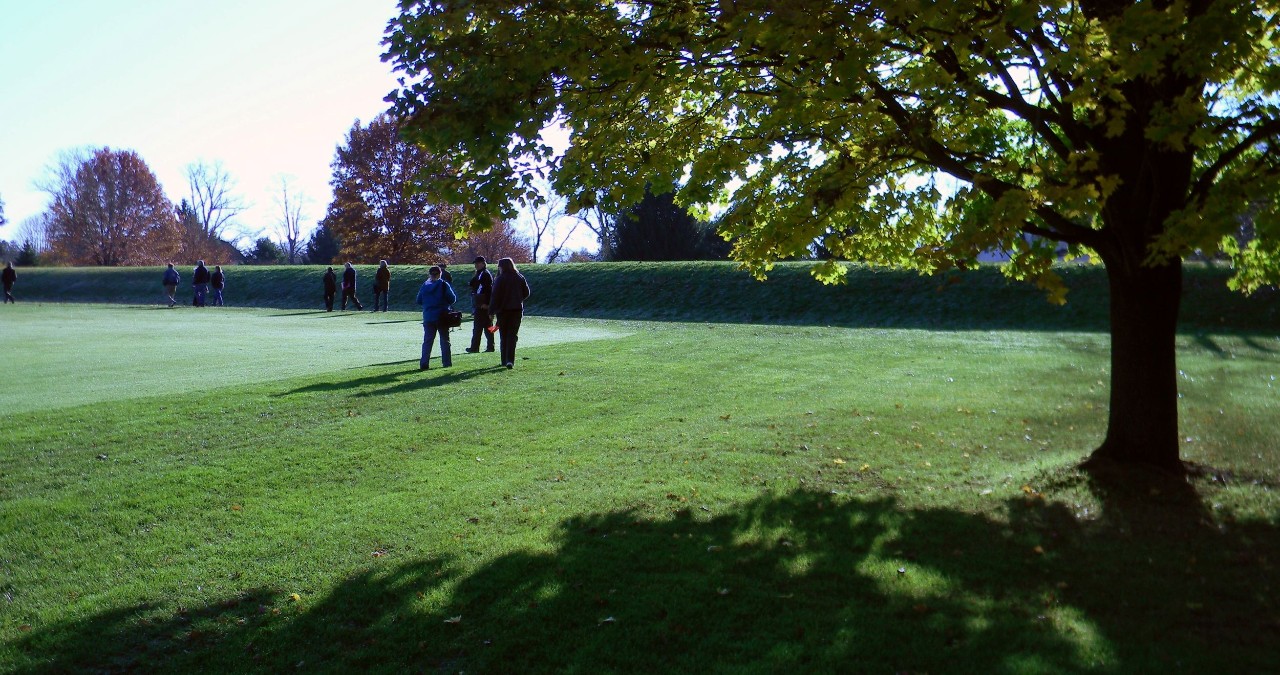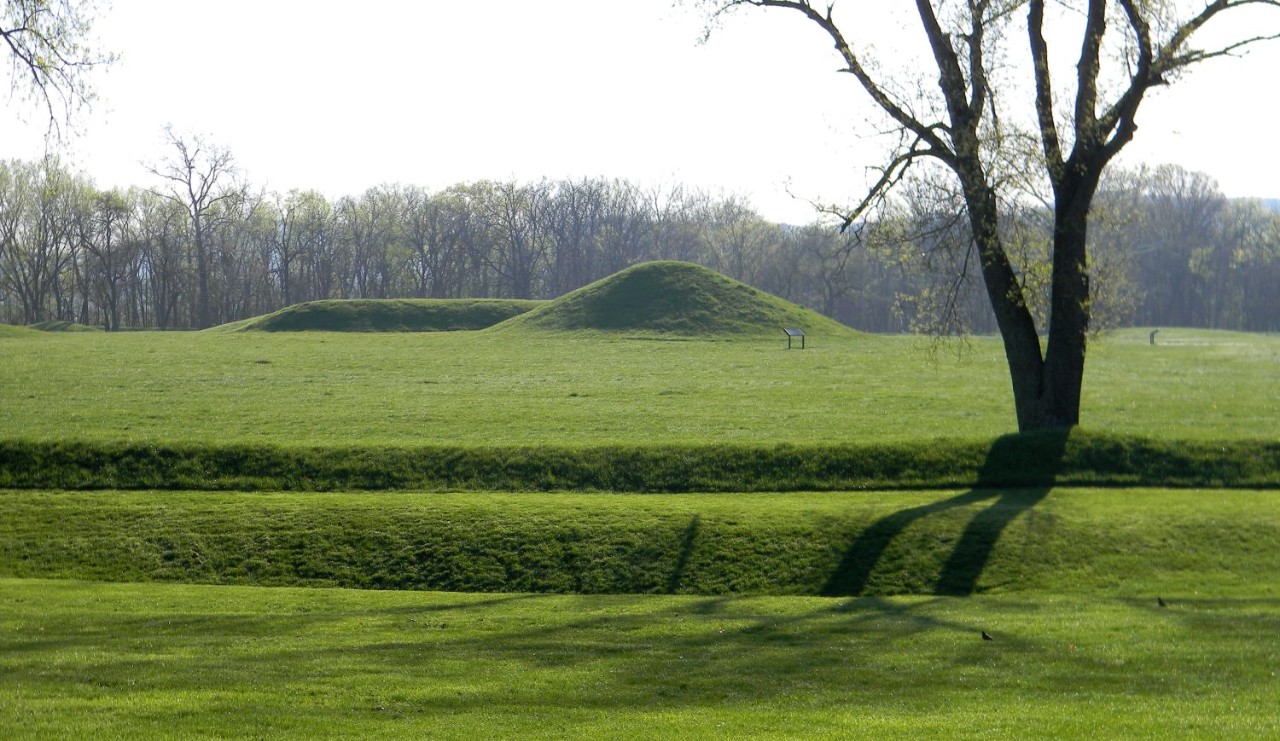
National media highlight newest US World Heritage site
UC faculty member on team who worked for decades to honor Ohio’s physical and cultural ancestry
University of Cincinnati professor emeritus John Hancock has seen his life’s work come to fruition, with the inscription of Ohio’s Hopewell Ceremonial Earthworks as a UNESCO World Heritage site.

Mound City, Chillicothe, Ohio at sunrise. Photo/John Hancock
The designation pertains to eight sites in central and southern Ohio where vast earthen structures were built by American Indigenous people nearly 2,000 years ago. These earthworks — huge geometric and hilltop enclosures, lined with gateways and ponds — served as central ceremonial sites for festivals and religious gatherings, likely based around observations of moonrises.
In an article in National Geographic, one site alone is described as being “capable of holding four Roman Coliseums.”
“People have no idea about the brilliance of this culture and the ancient architectural monuments that are around here,” Hancock says of first learning about the earthworks himself in the late 1990s while teaching architectural history and theory at UC’s College of Design, Architecture, Art, and Planning. (DAAP).
Calling it a “moment of discovery,” Hancock went on to secure federal, state and UC grants to research the earthworks and their builders, to develop methods for making them more comprehensible to the public and to create an online guide to all of Ohio’s earthworks.
From there, for nearly two decades, Hancock helped lead the team of archaeologists, historians and Native American scholars, including staff at the National Park Service and Ohio History Connection, all of whom worked tirelessly to make the case for the earthworks to be recognized on par with other World Heritage sites such as the Great Wall of China and Stonehenge.
One difficulty, as Hancock describes in a Slate magazine feature, was that the sites had been damaged over many decades by settlement, farming and industry.
“If a Greek temple is in ruins, you can see it, and it’s still pretty interesting,” Hancock told the magazine. However, many of the Hopewell sites in the region, he stated, were flat, covered in forest or simply too large in scale to be comprehensible. “We had to come up with a way of describing the integrity of the sites through a combination of the architecture you can see and the archaeological evidence you can’t see.”
Now that the Ohio earthworks are designated as World Heritage sites, the team is working to update and upgrade visitor experience materials, interpretive signage and online resources for the expected increase in regional tourism.
Featured image at top of Mound City provided by Hancock.
Impact Lives Here
The University of Cincinnati is leading public urban universities into a new era of innovation and impact. Our faculty, staff and students are saving lives, changing outcomes and bending the future in our city's direction. Next Lives Here.
Related Stories
Assistant Dean Leads Mascot Mania
October 13, 2002
Assistant Dean Jeannette Songer and her crew of student workers are pleased to introduce Elizabeth Bearcat Browning, the McMicken College of Arts & Sciences entry for "Mascot Mania," a new decorating contest modeled after Cincinnati's Big Pig Gig.
Students' New Tank Tops Much More Than a Fashion Statement
November 12, 2002
A new shirt created by UC co-op students Jaleen Francois and Regina Schneider will fight sexual assault, $10 at a time.
Real-World Project is All About Pressure
December 2, 2002
UC fashion students are designing better pressure garments to aid children and teens suffering from burn injuries.
Interior Design and Architecture Programs Make the Grade
December 12, 2002
The University of Cincinnati houses prized programs in interior design and architecture, according to an annual survey of U.S. architecture firms.
Architecture Students Sound Off With Designs of Note
January 15, 2003
About 120 first-year University of Cincinnati architecture and interior design students are fine tuning their skills by fashioning musical instruments from cast-off dishwashers, refrigerators and stoves.
'Home Work' Sculpture Nears An End
January 21, 2003
Part of UC's "tree" house sculpture was dismantled ahead of schedule.
Exhibit of Pop-Up Books Tells a Story
January 23, 2003
Whimsy, art and science all jump out at viewers of a pop-up book exhibit at the University of Cincinnati.
PROFILE: She Gets Those Dream Jobs, But She's Definitely No Dreamer
January 30, 2003
"Persistence pays off. I'm living proof." Coming from some people, that would definitely sound over the top. But after year hear a little about fashion alumna Angie Prewitt's grip-strong tenaciy and appetite for risks, you'll agree.
Documentary Gives Voice to Architects
February 4, 2003
University of Cincinnati professors have designed a documentary that describes the professional life of architects. Next, they'll record the views of those involved in Zaha Hadid's Contemporary Arts Center.
Architecture Students Learn Nuts-and-Bolts Lessons
February 5, 2003
It's "robo-rama" at UC's design college on Feb. 10, as architecture students display life-size "self-portrait" robots.


